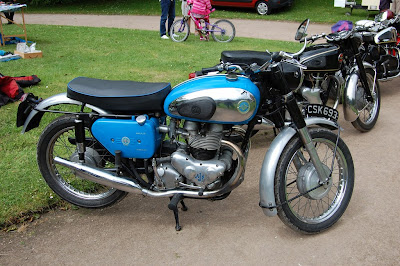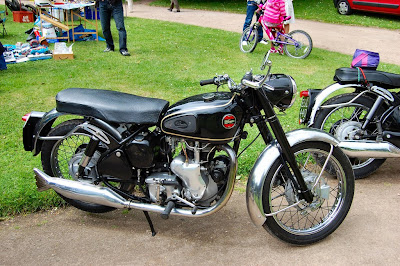 The Velocette Viper was a British motorcycle made by Velocette between 1955 and 1968. Built using traditional methods and materials, it struggled to compete against more modern machines, so from 1960 the designers added new glass fibre enclosure panels, making the Viper one of the first enclosed production motorcycles.[1]
The Velocette Viper was a British motorcycle made by Velocette between 1955 and 1968. Built using traditional methods and materials, it struggled to compete against more modern machines, so from 1960 the designers added new glass fibre enclosure panels, making the Viper one of the first enclosed production motorcycles.[1]Development
Introduced in October 1955, the single-cylinder Viper was developed from the 349cc Velocette MAC. Designed by Charles Udall, the Viper's 349cc engine had a bi-metal cylinder with a cast iron liner, high compression piston and a light alloy cylinder head. Using the same bottom end as its sister bike the 500cc Velocette Venom, the Viper had a lot of chrome plating and was offered in a choice of black or "willow green" paintwork. The Viper was also ahead of its time in being one of the first to have glass fibre enclosure panels from 1962. These panels proved unpopular with the traditional buyers of Velocette singles,[1] as they extended from the front of the engine, level with the top of the crankcase, to the rear pillion footrests.[2]
 The Triumph Tiger 100 (T100) was a British motorcycle first made by Triumph at their Coventry factory for 1939. As with previous models the '100' referred to its claimed maximum speed. It was developed as a 'sports' version of the Triumph Speed Twin. Finished in silver and costing £5 more, new features included a larger fuel tank and detachable silencers.[1]
The Triumph Tiger 100 (T100) was a British motorcycle first made by Triumph at their Coventry factory for 1939. As with previous models the '100' referred to its claimed maximum speed. It was developed as a 'sports' version of the Triumph Speed Twin. Finished in silver and costing £5 more, new features included a larger fuel tank and detachable silencers.[1]The Triumph works was destroyed by German bombers on the night of the 14th November 1940 - along with much of the city of Coventry bringing production of the Tiger 100 to an end until after the war. When Triumph recovered and began production again at Meriden the Tiger 100 re-appeared with the new telescopic fork. In 1951 it gained a new close finned alloy cylinder barrel and factory race kits for independent racers. In 1953 a fully race-kitted model, the Tiger 100C, was available although only 560 were made.[2]
1954 saw the first swinging-arm rear suspension models and the Tiger 100 was developed year on year alongside the other models in the range. 1959 was the last of the pre-units (separate engine/gearbox) and in 1960 it was completely redesigned in the new 'unit' style as the T100A. A long line of T100SS, T100C, T100R and others appeared during the sixties in the UK & export (mainly US) markets culminating in the Daytona variants which soldiered on until 1973. The historic Tiger name was revived by the new Hinckley Triumph company in 2001.
 The Triton was a modified Café racer motorcycle of the 1960s-1970s. The name derives from a contraction of Triumph and Norton; the two brands of motorcycle combined.
The Triton was a modified Café racer motorcycle of the 1960s-1970s. The name derives from a contraction of Triumph and Norton; the two brands of motorcycle combined.The intention was to combine the best elements of each to give a superior bike to either. The usual practice was to take the Triumph parallel twin engine and use it to replace the engine on a Norton Featherbed framed motorcycle that was regarded as the best handling motorcycle of the day. The Triumph Bonnevilles engine that already had twin carburettors was a popular engine choice. This engine, as well as other Triumph twin-cylinder engines, gave good performance and reliability and could be easily tuned for greater power by the addition of high-profile camshafts, high compression pistons and twin carburettors or fuel injectors amongst the more common power contributing modifications. There was also a Weslake 8 valve head available for the Triumph.
The Norton 650 and 750 vertical twin engines had a reliability problem. At about 7000 rpm the piston exceeds the engineering limit for piston speed, so over-revvers soon destroyed their engines. The BSA 650 had a bronze bush main bearing on the right hand side, doubling as the crank oil feed, with a lack of effective crankshaft end play control, that all had difficulty staying together when thrashed, even though the rest of the design was possibly better than the Triumph. The Triumph vertical twin used a ball on the timing side, and a roller on the other, with the oil feeding through a separate bronze bush in the outer right hand engine side cover. The Triumph was the pick of the bunch.
 The AJS Model 31 was a British motorcycle made by Associated Motorcycles at the former Matchless works in Plumstead, London. Developed in 1958 specifically to capture the potentially lucrative US market, the last Model 31 was produced in 1966.
The AJS Model 31 was a British motorcycle made by Associated Motorcycles at the former Matchless works in Plumstead, London. Developed in 1958 specifically to capture the potentially lucrative US market, the last Model 31 was produced in 1966. The Velocette Venom was a single cylinder four stroke British motorcycle of 499cc made by Velocette at Hall Green in Birmingham.[3] A total of 5721 Velocette Venoms were produced between 1955 and 1970.[4] In 1961 a production Velocette Venom set the 24-hour world record at a speed of 100.05mph. It was the first motorcycle of any size to achieve an average speed of over 100mph for 24 hours and to this date no other motorcycle of the same capacity has been able to equal this world record.[5] In 1965 the Velocette Venom was further developed by Velocette designer Bertie Goodman to create the Velocette Thruxton with a race specification cylinder head that was gas flowed by hand to accommodate extra-large valves and a downdraught inlet port. It was a very popular and successful clubman racer. However, although it had more power than the Venom, the Thruxton couldn't save Velocette.[3] Poor sales forced the the company into voluntarily liquidation in 1971, with all the remaining stock and tools sold off to pay creditors.
The Velocette Venom was a single cylinder four stroke British motorcycle of 499cc made by Velocette at Hall Green in Birmingham.[3] A total of 5721 Velocette Venoms were produced between 1955 and 1970.[4] In 1961 a production Velocette Venom set the 24-hour world record at a speed of 100.05mph. It was the first motorcycle of any size to achieve an average speed of over 100mph for 24 hours and to this date no other motorcycle of the same capacity has been able to equal this world record.[5] In 1965 the Velocette Venom was further developed by Velocette designer Bertie Goodman to create the Velocette Thruxton with a race specification cylinder head that was gas flowed by hand to accommodate extra-large valves and a downdraught inlet port. It was a very popular and successful clubman racer. However, although it had more power than the Venom, the Thruxton couldn't save Velocette.[3] Poor sales forced the the company into voluntarily liquidation in 1971, with all the remaining stock and tools sold off to pay creditors.
0 comments:
Post a Comment